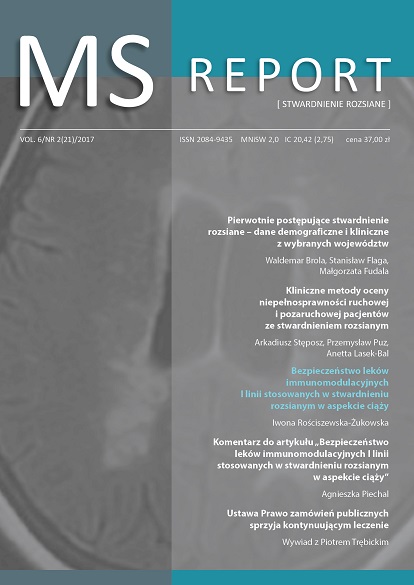Pierwotnie postępujące stwardnienie rozsiane – dane demograficzne i kliniczne z wybranych województw Artykuł przeglądowy
##plugins.themes.bootstrap3.article.main##
Abstrakt
Postępujące stwardnienie rozsiane, zwłaszcza jego postać pierwotnie postępująca, jest obecnie przedmiotem intensywnych badań i ożywionej dyskusji. Odrębny przebieg tej postaci z charakterystyczną symptomatologią i ze zmianami w badaniu rezonansu magnetycznego stał się podstawą rozważań, czy nie jest to odmienna choroba demielinizacyjna. Zasadnicza cecha postaci pierwotnie postępującej to stopniowe narastanie objawów wynikających przede wszystkim z zajęcia rdzenia kręgowego, z niewielkimi fluktuacjami, ale bez wyraźnych rzutów. O postaci tej wciąż wiemy niewiele, tymczasem szacuje się, że występuje ona u 10–20% pacjentów. W artykule, na podstawie danych z Rejestru Chorych ze Stwardnieniem Rozsianym, przedstawiono polskie obserwacje dotyczące przebiegu tej postaci choroby i jej odmienności w stosunku do postaci rzutowo-remisyjnej. Stwierdzono, że postać pierwotnie postępująca występuje u blisko 10% polskich chorych na stwardnienie rozsiane, pierwsze objawy pojawiają się około 40. r.ż. z jednakową częstością u obu płci, a jej rozpoznanie zajmuje ponad dwukrotnie więcej czasu niż rozpoznanie postaci rzutowo-remisyjnej.
##plugins.themes.bootstrap3.article.details##
Copyright © by Medical Education. All rights reserved.
Bibliografia
2. Kingwell E., Marriott J.J., Jetté N. et al.: Incidence and prevalence of multiple sclerosis in Europe: a systematic review. BMC Neurol. 2013; 13: 128.
3. Brola W., Sobolewski P., Flaga S. et al.: Increasing prevalence and incidence of multiple sclerosis in Poland. Neurol. Neurochir. Pol. 2017; 51: 82-85.
4. Potemkowski A.: Stwardnienie rozsiane w świecie i w Polsce – ocena epidemiologiczna. Aktualn. Neurol. 2009; 9: 91-97.
5. Lassmann H.: Brain damage when multiple sclerosis is diagnosed clinically. Lancet 2003; 361: 1317-1318.
6. Lublin F.D., Reingold S.C., Cohen J.A. et al.: Defining the clinical course of multiple sclerosis: the 2013 revisions. Neurology 2014; 83: 278-286.
7. Thompson A.J., Polman C.H., Miller D.H. et al.: Primary progressive multiple sclerosis. Brain 1997; 120: 1085-1096.
8. Miller D.H., Leary S.M.: Primary-progressive multiple sclerosis. Lancet Neurol. 2007; 6: 903-912.
9. Antel J., Antel S., Caramanos Z. et al.: Primary progressive multiple sclerosis: part of the MS disease spectrum or separate disease entity? Acta Neuropathol. 2012; 123: 627-638.
10. Cottrell D.A., Kremenchutzky M., Rice G.P.A. et al.: The natural history of multiple sclerosis: a geographically based study. 5. The clinical features and natural history of primary progressive multiple sclerosis. Brain 1999; 122: 625-639.
11. Jacobs L.D., Wende K.E., Brownscheidle C.M. et al.: A profile of multiple sclerosis: the New York State Multiple Sclerosis Consortium. Mult. Scler. 1999; 5: 369-376.
12. Confavreux C., Vukusic S.: Natural history of multiple sclerosis: a unifying concept. Brain 2006; 129: 606-616.
13. Verjans E., Theys P., Delmotte P. et al.: Clinical parameters and intrathecal IgG synthesis as prognostic features in multiple sclerosis. Part I. J. Neurol. 1983; 229: 155-165.
14. Minderhoud J.M., van der Hoeven J.H., Prange A.J.: Course and prognosis of chronic progressive multiple sclerosis. Results of an epidemiological study. Acta Neurol. Scand. 1988; 78: 10-15.
15. Kantarci O.H., Weinshenker B.G.: Natural history of multiple sclerosis. Neurol. Clin. 2005; 23: 17-38.
16. Brola W., Sobolewski P., Flaga S. et al.: Pierwotnie postępująca postać stwardnienia rozsianego w populacji polskich pacjentów. Aktualn. Neurol. 2017; 17(1): 5-14.
17. Shepherd D.I.: Clinical features of multiple sclerosis in north-east Scotland. Acta Neurol. Scand. 1979; 60: 218-230.
18. Confavreux C., Aimard G., Devic M.: Course and prognosis of multiple sclerosis assessed by the computerized data processing of 349 patients. Brain 1980; 103: 281-300.
19. Weinshenker B.G., Bass B., Rice G.P. et al.: The natural history of multiple sclerosis: a geographically based study. I. Clinical course and disability. Brain 1989; 112: 133-146.
20. Andersson P.B., Waubant E., Gee L. et al.: Multiple sclerosis that is progressive from the time of onset: clinical characteristics and progression of disability. Arch Neurol. 1999; 56: 1138-1142.
21. McDonnell G.V., Hawkins S.A.: Clinical study of primary progressive multiple sclerosis in Northern Ireland, UK. J. Neurol. Neurosurg. Psychiatry 1998; 64: 451-454.
22. Tremlett H., Paty D., Devonshire V.: The natural history of primary progressive MS in British Columbia, Canada. Neurology 2005; 65: 1919-1923.
23. Kremenchutzky M., Rice G.P.A., Baskerville J. et al.: The natural history of multiple sclerosis: a geographically based study 9: observations on the progressive phase of the disease. Brain 2006; 129: 584-594.
24. Bashir K., Whitaker J.N.: Clinical and laboratory features of primary progressive and secondary progressive MS. Neurology 1999; 53: 765-771.
25. Ebers G.C.: Disease evolution in multiple sclerosis. J. Neurol. 2006; 253(supl. 6): vi3-vi8.
26. Montalban X.: The importance of long-term data in multiple sclerosis. J. Neurol. 2006; 253(supl. 6): 9-15.
27. Sastre-Garriga J., Ingle G.T., Rovaris M. et al.: Long-term clinical outcome of primary progressive MS: predictive value of clinical and MRI data. Neurology 2005; 65: 633-635.
28. Tremlett H., Paty D., Devonshire V.: Disability progression in multiple sclerosis is slower than previously reported. Neurology 2006; 66: 172-177.
29. Vukusic S., Confavreux C.: Prognostic factors for progression of disability in the secondary progressive phase of multiple sclerosis. J. Neurol. Sci. 2003; 206: 135-137.
30. Wolinsky J.S., Narayana P.A., O’Connor P. et al.; PROMiSe Trial Study Group: Glatiramer acetate in primary progressive multiple sclerosis: results of a multinational, multicenter, double-blind, placebo-controlled trial. Ann. Neurol. 2007; 61: 14-24.
31. Noseworthy J., Paty D., Wonnacott T. et al.: Multiple sclerosis after age 50. Neurology 1983; 33: 1537-1544.
32. Brola W., Sobolewski P., Flaga S. et al.: Prevalence and incidence of multiple sclerosis in central Poland, 2010–2014. BMC Neurol. 2016; 16: 134.

